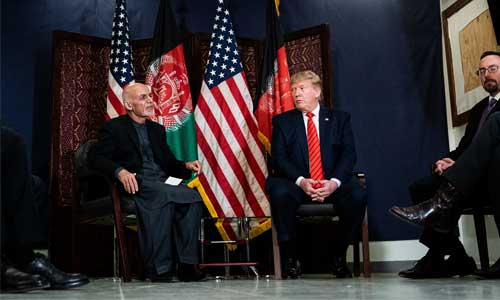Afghanistan became significant for the United States and for the world as a whole after the incident of 9/11. Taliban, the rulers in Afghanistan at the time, refused to break links with Al-Qaeda (the mastermind of the 9/11 attacks) and make their members leave the country. The United States decided to launch Operation Enduring Freedom (OEF) in Afghanistan and soon they were able to defeat Taliban. However, they have not been able to attain something remarkable as far as the claimed state-building slogans were concerned, neither they are able to extract themselves out of the situation even after 19 years of involvement that has cost around $1 trillion in combat and development costs.
US policy towards Afghanistan since 9/11 has been a major concern for every president since 2001. In fact, presidential candidates in the US have been highlighting their policies towards Afghanistan in their presidential campaigns to secure the confidence and the votes of the people. And, after winning elections, every president since President Bush has been disseminating Afghan policy through various means. It is also because of the fact that a large sum of US taxpayers’ money has been used in Afghanistan.
When Donald Trump became the president of the US in 2016, he inherited his Afghan policy from President Barrack Obama, who despite his promises was not able to conclude the War in Afghanistan. It was the time, when people in the US had started questioning the worth of the war and its outcome, as they could see that the Taliban were gaining strength against the US forces and the so-called democratic government that had the support of the US despite the US losses in blood and money. Donald Trump during his presidential campaigns promised to the people that he would conclude the Afghan war and withdraw all US forces from the country.
President Trump, after assuming power, hinted in his speech in August 2017 at a political settlement in Afghanistan; however, he thought it to be possible through effective military effort. Nevertheless, the ambiguities remained about the details of the policy. In 2018, however, there were some tangible efforts by Trump administration, when US-Taliban talks started in Qatar in the month of July. Though this was a deviation from the previous stance of the Trump administration to pursue an Afghan-led and Afghan-owned peace process, it nevertheless started some sort of process. US’s direct talks with Taliban though provided an opportunity to Washington to comprehend Taliban demands, they, however, displeased the National Unity Government (NUG) led by President Ashraf Ghani in Afghanistan.
The US effort for a US-Taliban agreement before starting intra-Afghan peace talks got a new momentum when Trump Administration appointed Zalmay Khalilzad as the US Special Envoy for Reconciliation in Afghanistan in September 2018. Zalmay Khalilzad held direct talks with Taliban representatives in Qatar and also made several visits to Afghanistan, Pakistan and other regional countries for the process to take shape. The most important realization that Khalilzad made was the role of Pakistan for assisting in bringing Taliban to negotiation table. As Pakistan was considered to have influence over the group, Khalilzad asked the Pakistani military and civilian leadership to play a role in making the agreement possible. At the same time, change of leadership in Pakistan also called for a peaceful resolution to Afghan conflict and pushed for intra-Afghan talks. Therefore, on Khalilzad’s request, Pakistan released Mullah Abdul Ghani Baradar in October 2018, who was in custody since 2010. Mullah Baradar later participated in the talks as Taliban representative in Qatar.
With efforts extending more than a year, US and Taliban at last reached to an agreement in February 2020. As per the agreement, the US made commitments to withdraw all its forces from Afghanistan within 14 months, while the Taliban agreed not to allow Al-Qaeda or any other terrorist group to use Afghan soil against the US. They also agreed to participate in an intra-Afghan peace process with Afghan ‘government’. Though there were certain hurdles in the way to intra-Afghan peace process, like the differences between Taliban and Kabul administration regarding prisoners’ release process, and the disagreements that erupted between President Ghani and Dr Abdullah Abdullah because of the results of presidential election in Afghanistan. However, the prisoners’ release process was at last finalized and Abdullah and Ghani made a political agreement in May 2020. As per the agreement, High Council for National Reconciliation was formed that was to be led by Abdullah and his team.
Though intra-Afghan talks have started, there are evidences that already show that the talks will be very tiresome and would require honest and dedicated efforts by all the parties. For Trump administration, the intra-Afghan peace talks will mark the final step in its Afghanistan policy. However, the overview of the policy shows inconsistent efforts, as there were no significant development or policy initiative in first two years by Trump administration. Since, they started late, they are now in urgency to finalize the process as soon as possible. Trump wants troops withdrawal from Afghanistan whether there is a guarantee of peace in Afghanistan or not. He wants to use the situation in his favor before the US presidential election. Nevertheless, a comprehensive and lasting peace in Afghanistan is not achievable through such a policy. For that the US needs to see the situation in the light of challenges existing within the socio-political scenario in the country.
Home » Opinion » Trump’s Afghanistan Policy
Trump’s Afghanistan Policy
| Sajjad Aasim

